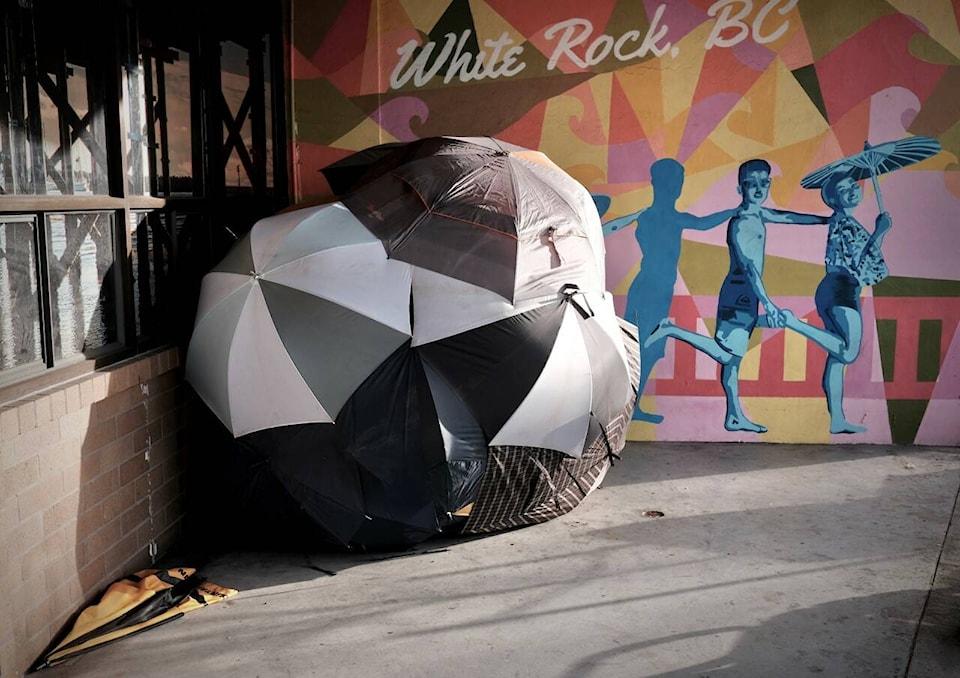While many were hoping that last winter’s response to homelessness in South Surrey and White Rock would be a learning opportunity about the importance of consistent care, an overnight shelter in this area has not yet opened and the city as a whole has “significantly” fewer beds open so far this year.
An escape from the cold is available in the community during the day, but the nighttime right now offers less comfort than last year, by a wide margin.
“You’ve lost 90 beds this year so far,” estimates Wayne Kallen, manager of Extreme Weather Response and Surrey Urban Mission.
The South Surrey shelter, which usually holds between 25 and 30 beds, makes up one-third of those lost beds.
Other locations that were open last year include a shelter in Guildford and another near Surrey Memorial Hospital.
While these locations are still attempting to get their doors open soon, Kallen said, several people are being turned out to the streets in the meantime.
“We are turning people away. The first few nights, the highest number we were turning away was 13 people,” Kallen said, of the 15-bed Surrey Welcome Hub extreme weather shelter.
Following the Nov. 3 open for the Welcome Hub, staff quickly realized just how little space they had for unhoused people, which then allowed the centre to oversee another 16 beds at a nearby shelter, Nightshift Street Ministries.
“We look at the homeless count this year and we have about 46 beds this year, including North Delta. We need more,” Kallen stressed.
The point-in-time homeless count’s numbers, released for Greater Vancouver on Oct. 5, found that Surrey’s homeless population had grown by 65 per cent since 2020, nearly twice the regional average of 32 per cent.
RELATED: Surrey’s homeless population has risen by 65% since 2020
Even with the opening of Nightshift and some folks getting into a shelter in a North Delta church, Kallen said there are still many people sleeping outdoors.
“We’re still turning people away. We turned seven people away last night (Nov. 27) at Nightshift and we turned three or four away from the Surrey Welcome Hub.”
Serious medical concerns
A White Rock doctor is very concerned about the safety of the unhoused population on the Semiahmoo Peninsula.
Dr. Rogan Thavarajah, a family physician, provided health care for about a month last winter at the city’s warming centre, and is gearing up to provide care for the whole coming season.
Last year, the overnight shelter in the area had closed earlier than expected, bringing about more challenges with those who slept outdoors.
“There were individuals that were starting their own fires using, I think, hand sanitizer and then that was causing significant burns. We were seeing those after the fact, so maybe they had been to hospital, maybe they hadn’t been to hospital.”
Even if temporary shelter is arranged this year, whether it will remain open for the entire cold weather season remains to be seen.
If the response is more consistent this year, doors can then be opened for the individuals to gain access to other supports they may be needing, Thavarajah noted.
“There’s a lot of mental health issues, there’s chronic disease, there’s emphysema, heart failure,” Thavarajah said, adding that these concerns exist in conjunction with many physical injuries from the weather or not being in a shelter overnight.
“All of the medical problems that we see anyways as family physicians, they are more prevalent. There is a high number of people with complex medical issues, that’s what we saw.”
While working out of the daytime warming centre for about a month last winter, Thavarajah and his nurse came in at the tail-end of the cold weather season and did “exploratory work because we didn’t know what we would see.”
“The challenge is seeing people in what isn’t an ideal setting and being able to provide the care that they need. We’re kind of operating out of a corner in their (warming centre) space and we’re making ourselves available to them for support.”
Recognizing that many people who have experience living on the streets have not had positive encounters with the medical system, Thavarajah knew he had some work cut out for him.
“After being there two, three weeks, people started to maybe recognize us and maybe, as they were seeing us help other individuals they were perhaps becoming a bit more forthcoming,” he said, adding that many were hesitant at first.
Thavarajah also operates a health clinic out of the Sources food bank in South Surrey once a week, treating vulnerable populations who face significant barriers in accessing healthcare. Through that work over the last couple months, the doctor has helped some patients gain access to transitional housing.
RELATED: New health clinic for vulnerable people opens in South Surrey
The hope is to continue this work, as Fraser Health’s Integrated Homelessness Action Response Team (IHART) is working in conjunction with the doctor, along with other social and mental health workers.
“We can carry forward this work and not let it end in the spring.”
